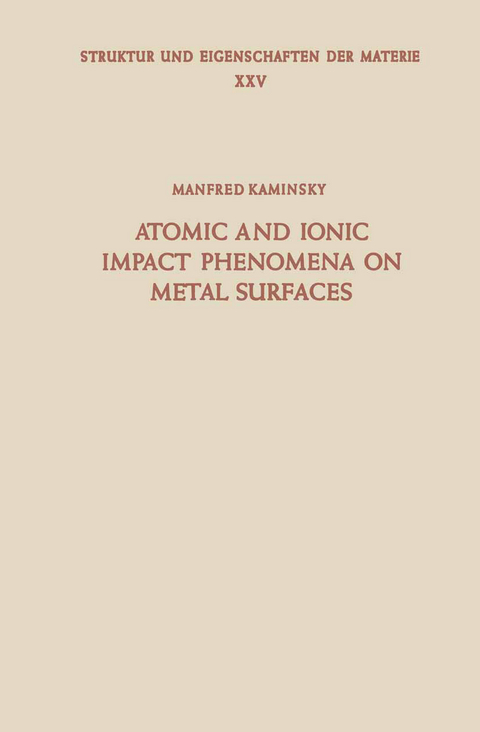
Atomic and Ionic Impact Phenomena on Metal Surfaces
Springer Berlin (Verlag)
978-3-642-46027-2 (ISBN)
1. The Nature of the Metal Surface.- 1.1. The Heterogeneous Surface.- 1.2. Theoretical Description of Metal Surfaces. The Work function.- 2. Determination of the Work Function of Metal Surfaces.- 2.1. Thermal Emission of Electrons.- 2.2. Thermal Emission of Ions.- 2.3. Photoelectric Method.- 2.4. Method Based on the Field Emission of Electrons.- 2.5. Measurements of Contact Potential.- 2.6. Electron Reflection Method.- 3. Preparation of Metal Surfaces.- 3.1. Thermal Desorption; the Flash-Filament Method.- 3.2. Ion Bombardment of the Surface.- 3.3. Evaporation of Thin Layers.- 3.4. Galvanotechnic Procedures.- 4. Binding Forces Effective in the Collision of Atoms and Molecules with Metal Surfaces.- 4.1. vanderWaals Forces-Physical Adsorption.- 4.2. Exchange Forces-Weak Chemisorption on Homogeneous and Heterogeneous Surfaces.- 4.3. Heteropolar Binding Forces-Strong Chemisorption.- 5. Energetics of Surface Reactions.- 5.1. General Remarks and Definitions.- 5.2. Heats of Adsorption for Physical Adsorption.- 5.3. Heats of Adsorption for Weak Chemisorption.- 5.4. Heats of Adsorption for Strong Chemisorption.- 6. Inelastic Collisions of Atoms and Molecules with Metal Surfaces: The Accommodation Coefficient.- 6.1. Definition and General Remarks.- 6.2. Methods for Measuring Accommodation Coefficients.- 6.3. Experimental Results on Accommodation Coefficients.- 6.4. Determination of Relaxation Times for the Process of Energy Exchange between the Normal Vibrational States of the System Comprising Adsorbed Molecule and Metal Surface.- 7. Elastic Collisions of Atoms and Molecules with Metal Surfaces.- 8. Emission of Positive Ions Formed at Metal Surfaces (Surface Ionization).- 8.1. Theoretical Considerations.- 8.2. Relation of the Saha-Langmuir Equation to the Frenkel Equationand to Charge-Transfer Probabilities.- 8.3. Experimental Investigation of Positive Surface Ionization (PSI).- 9. Formation and Emission of Negative Ions at Metal Surfaces (NSI).- 9.1. Theoretical Considerations.- 9.2. Experimental Methods.- 9.3. Experimental Results.- 10. Sputtering of Metal Surfaces by Ion Bombardment.- 10.1. Introduction.- 10.2. Experimental Methods.- 10.3. Experimental Results.- 10.4. Theoretical Treatments of the Sputtering Process.- 11. Ion Scattering from Metal Surfaces.- 11.1 Definitions: Ion-Reflection Coefficient and Secondary-Emission Coefficient.- 11.2 Experimental Techniques.- 11.3. Experimental Ion-Reflection and Secondary-Emission Coefficients.- 11.4. Theoretical Treatment of Ion Scattering from Metal Surfaces.- 12. Neutralization of Ions on Metal Surfaces (Potential Emission of Secondary Electrons).- 12.1. Introductory Remarks and Definitions.- 12.2. Auger Neutralization; Resonance Neutralization.- 13. De-excitation of Metastable Atoms and Ions on Metal Surfaces.- 13.1. Introductory Remarks and Description of Experimental Methods.- 13.2. Experimental Data for the Total Yield and Energy Distribution of Secondary Electrons from De-excitation of Metastable Atoms and Ions on Metal Surfaces.- 13.3. Theoretical Aspects of the Auger De-excitation of Metastable Atoms on Metal Surfaces.- 14. The Emission of Electrons from Metal Surfaces by Bombardment with Charged and Uncharged Particles (Kinetic Emission).- 14.1. Introduction.- 14.2. Experimental Methods.- 14.3. Experimental Results.- 14.4. Theoretical Aspects of the Kinetic Emission of Secondary Electrons.- Literature.- Author Index.
| Erscheint lt. Verlag | 9.4.2012 |
|---|---|
| Reihe/Serie | Struktur und Eigenschaften der Materie in Einzeldarstellungen |
| Zusatzinfo | XII, 402 p. 15 illus. |
| Verlagsort | Berlin |
| Sprache | englisch |
| Maße | 155 x 235 mm |
| Gewicht | 627 g |
| Themenwelt | Naturwissenschaften ► Chemie ► Analytische Chemie |
| Naturwissenschaften ► Physik / Astronomie ► Atom- / Kern- / Molekularphysik | |
| Naturwissenschaften ► Physik / Astronomie ► Festkörperphysik | |
| Schlagworte | Atom • Collision • Corrosion • Crystal • electron • Energy • Fields • Information • Metalloberfläche • metals • particles • scattering • spectroscopy • Stoss • Stoss (Techn.) • Thin Films |
| ISBN-10 | 3-642-46027-5 / 3642460275 |
| ISBN-13 | 978-3-642-46027-2 / 9783642460272 |
| Zustand | Neuware |
| Haben Sie eine Frage zum Produkt? |
aus dem Bereich


